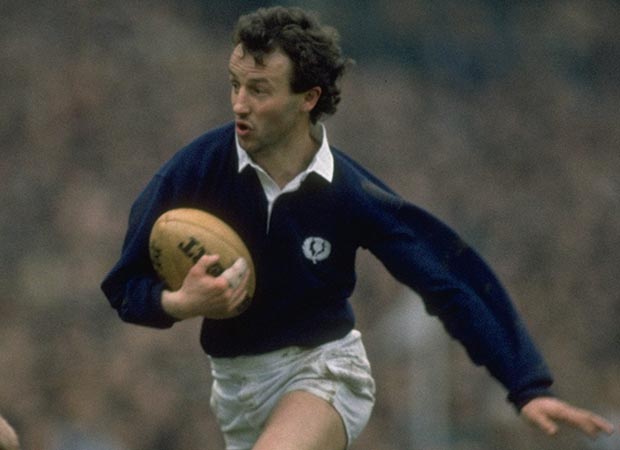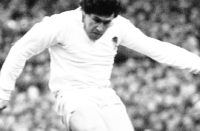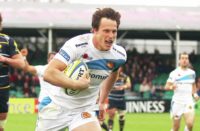 When I began playing, in U19s age group rugby, at Melrose, you had to have boiled white shorts, polished black boots and boiled white laces if you wanted to play on a Saturday, such were the high standards that our coaches, former Scottish international half-backs, Dave Chisholm and Alex Hastie set.
When I began playing, in U19s age group rugby, at Melrose, you had to have boiled white shorts, polished black boots and boiled white laces if you wanted to play on a Saturday, such were the high standards that our coaches, former Scottish international half-backs, Dave Chisholm and Alex Hastie set.
I had to do everything possible to convince our coaches that I wasn't too small to play when I was 15 years old. I do believe that period helped give me the determination to reach the levels that I did.
At Melrose, the only club that I ever played for, we used to get some severe hammerings from our stronger Border rivals, Hawick and Gala. It wasn't until the 1989/90 season, my swansong year that we won our first Scottish 1st Division Championship, with players such as Bryan Redpath and Craig Chalmers breaking through. Prior to that season, we struggled to get enough possession, so I just set out to play rugby from anywhere on the park, much to the frustration of our coach Jim Telfer who'd be ranting and raving in the stand.
My Melrose debut came against our local rivals, Gala, and a player called John Frame, who, at 6'3 and 15.5 stone, had a totally different physique to me. I was like a stick-insect by comparison. John wouldn't have looked out of place as a modern-day centre, but luckily for me he was a gentleman. After running through me once, he didn't bother doing it again. I remember Mike Teague once saying to me, during a tour to South Africa, in 1989, that if he had legs like mine he'd have been too embarrassed to play rugby!
I was so skinny that I had to put weights in my shorts to make sure I was over 11 stone at the ‘weigh-in' before my first international against the All Blacks at Murrayfield. Had Ian McGeechan's late drop-goal attempt gone over we might have pulled off a shock draw. Instead it was charged down and another Robertson, New Zealander Bruce, ran virtually the length of the field for the game-clinching try. That match was the most scared I'd ever been before kick-off, as I was up against the player I reckoned to be the best winger in the world at that time, the physically imposing Bryan Williams, whereas I was playing my first game on the wing and giving away about four stones.
Although I played in every position in the backs, outside of the half-backs for Scotland, most of rugby was on either wing or in the in the centre, where I was lucky enough to play alongside the great Jim Renwick. For me, Jim was probably the most under-rated player in Scotland whereas he was revered everywhere else. I think his light-heartedness didn't go down well with our dour management.
Of the many highlights I enjoyed with Scotland beating England in their own backyard, in 1983, is right up there amongst the best. I felt fully involved throughout the 80 minutes and probably had my best game in the blue jersey. Scoring against Ireland, to win the Triple Crown on our way to the 1984 Grand Slam, was special, as was the Grand Slam itself, full stop.
To have had the opportunity to play in the first World Cup was great too. If we'd have beaten France in the pool stages, instead of drawing with them, we'd have avoided New Zealand in the knockout stages and who knows how far we could have gone. It was great to finally play in New Zealand as I'd missed the 1981 trip there because my first daughter was due at that time.
When I retired from playing I went on to hold the position of CEO of Scottish First Division Rugby Ltd, which had been formed by the nine leading clubs to provide a blueprint for the professional game in Scotland. We were at odds with the Scottish Rugby Union's vison of the future. We believed that developing the professional game, through a District format, controlled by the SRU, was flawed and, unfortunately, I believe we have been proven right. I remember the late Duncan Paterson, one of the SRU's prominent figures, at the time, saying that the SRU wouldn't let the clubs bankrupt Scottish rugby and Jim Telfer had a vision of 50,000 new, rugby theatre supporters. Of course, in hindsight, the game has lost supporters and the SRU almost bankrupted themselves.
We could not see a position where entrepreneurs and businesses would invest in clubs where they didn't have the control to run them as they saw fit. The poor financial position, of the SRU, has resulted in there being only two professional teams in Scotland and that, as far as I am concerned, is one of the biggest reasons why Scottish rugby is not developing the way it should be.
Unfortunately, my involvement in rugby has been negligible, over the past few years, other than watching the odd Melrose game and following the exploits of my son, Scotland Sevens internationalist Mark, on the World Series. Semi-retirement, from my business beckons and, who knows, I may stir a few things up, within the belly of the SRU, in the future.
*As told to Jon Newcombe



























